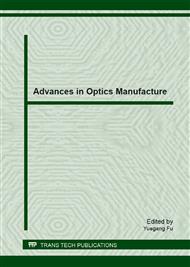p.313
p.319
p.325
p.329
p.339
p.345
p.349
p.356
p.361
Analysis of Influence of Beam Expender Parameters on Coupling Efficiency of Single Mode Fiber Used in Lidar
Abstract:
Based on theoretical analysis, the beam expender used in all fiber lidar with a coupling efficiency of single mode fiber (SMF) is investigated. Some numerical computations are carried out and following results are obtained. For all fiber lidar in order to get the maximum coupling efficiency on SMF, the relationship between the distance d, ranged from the secondary to primary lens of the beam expender, and the laser waist spot location l, which is at a distance from the secondary lens of beam expender are obtained. And also the relationship between l and the measurable bandwidth is analyzed. Under the condition that if the laser location is certain and the imagine spot location is infinite, with adjusting the distance d which can make the image spot size obtain its minimum, the maximum coupling efficiency about 70.6% is got and the adjusting range of d has only 0.2~0.9mm. Assuming that the image spot distance is infinite, and the minimum of spot radius is got after the laser waist spot goes through the beam expender, the function between d and l is retrieved by use of laser propagation theory. By comparing the theoretical curve with the computing one, the theoretical function agrees with the numerical computing curve approximately. These conclusions have the important directive significance for design of all fiber Lidar.
Info:
Periodical:
Pages:
339-344
Citation:
Online since:
May 2013
Authors:
Keywords:
Price:
Сopyright:
© 2013 Trans Tech Publications Ltd. All Rights Reserved
Share:
Citation:


